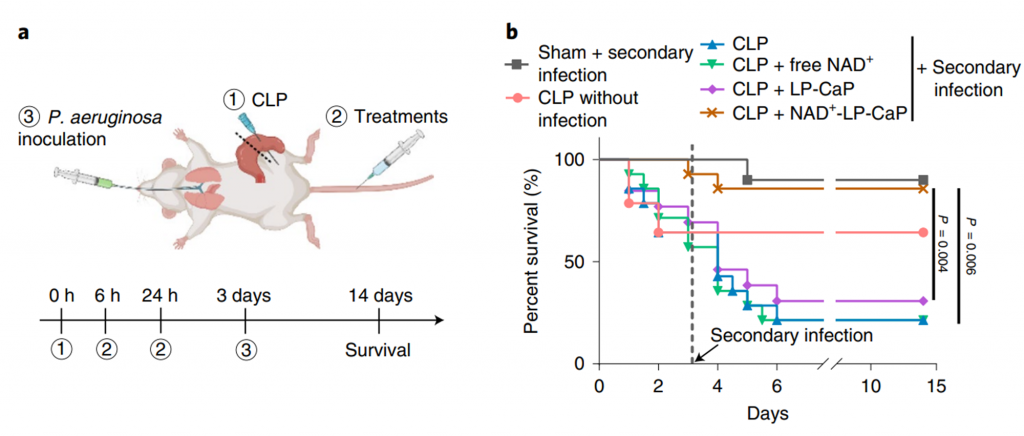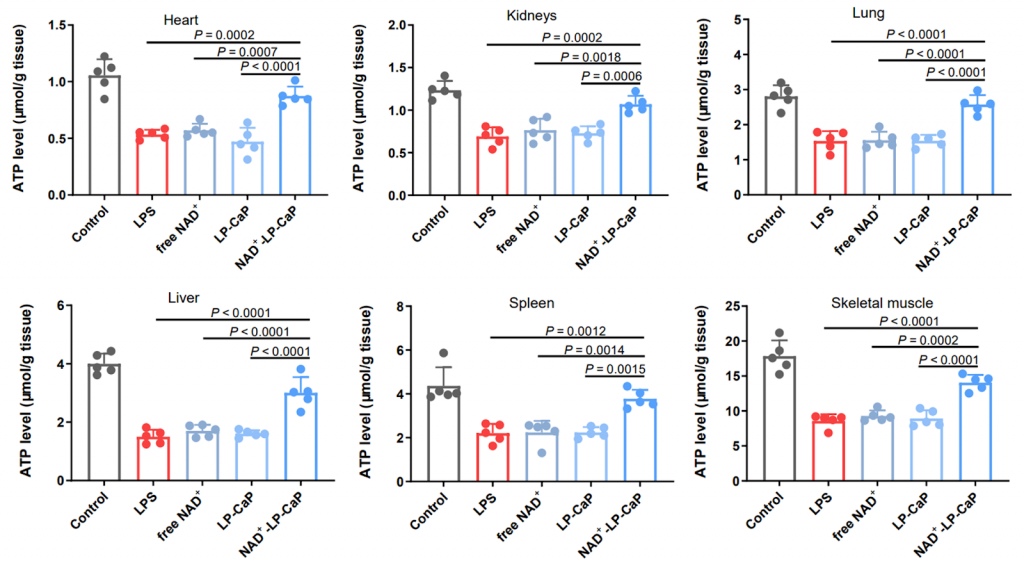Key Points:
- Treating septic mice with lipid nanoparticles (NPs) loaded with nicotinamide adenine dinucleotide (NAD+) increases their survival rate from 21% to 93%.
- Treatment with loaded NPs stops immune cells from dying, blocking the immunosuppressive response caused by sepsis.
- The primary cell energy currency (ATP) is restored in multiple organs of septic mice following treatment with NAD+ NPs, suggesting the prevention of multiple organ failure.
When the body is attacked by foreign invaders, our internal troopers – white blood cells – stimulate an inflammatory response to defend against infection. However, with aging comes an increased susceptibility to sepsis – an extreme response to infection characterized by persistent, uncontrolled inflammation that leaves the body vulnerable to unintended tissue damage, multiorgan dysfunction, and death. With this in mind, scientists have continually searched for effective therapeutics to regulate the body’s immune response to sepsis.
In a new study published in Nature Nanotechnology, Ye and colleagues successfully modulate the immune response to sepsis in mice by treating them with NPs loaded with the life-preserving molecule NAD+. The University of Wisconsin researchers found that treatment with loaded NPs increased the survival of septic mice and hindered the inflammation-induced apoptosis (cell death) that normally occurs with sepsis. What’s more, this novel NAD+ treatment replenished cellular ATP levels in multiple major organs of septic mice including the heart, liver, kidneys, spleen, lungs, and muscle, demonstrating its ability to protect against sepsis-mediated organ damage.
NAD+ Increases Survival in Septic Mice
Sepsis is a ruthless disease with an extremely high mortality rate. In fact, one-third of sepsis survivors die within one year following hospitalization due to secondary complications. Thus, identifying treatments that can mitigate post-infection complications is of the utmost importance. Ye and colleagues sought to determine whether treatment with NAD+ could improve survival in septic mice. Notably, NAD+’s charge and size prevent it from readily crossing the cell membrane to be utilized by cells. However, NP’s bypass this issue, which is why investigators experimented with NAD+ loaded NPs to fully harness NAD+’s immune-boosting effects.
Mice initially underwent surgery to induce sepsis and were treated with either free NAD+, empty NPs, or NAD+ loaded NPs. Three days later, the mice were injected with a particular bacteria (P. aeruginosa) to mimic secondary infections. Compared to untreated mice, with a mortality rate of 79%, mice treated with NAD+ NPs exhibited a 7% mortality rate. Conversely, free NAD+ or empty NPs failed to improve survival in septic mice. Taken together, these findings suggest that NAD+ NPs mitigate the initial hyperinflammatory septic response, as well as secondary infections.

Loaded NPs Block Immune Cell Apoptosis
Following the hyperinflammatory stage of sepsis is a secondary phase known as immunosuppression where the body’s defense systems become obsolete. One of the primary drivers of immunosuppression is immune cell apoptosis (immune cell death), particularly of lymphocytes. Lymphocytes are the white blood cells responsible for antibody production, the removal of virus-infected cells and tumor cells, and modulation of the immune response. To analyze the effects of NAD+ NPs on immune cell apoptosis, Ye and colleagues quantified the amount of healthy cells and apoptotic cells (dead cells) in the blood, lungs, and spleen of septic mice following treatment. Results showed that septic mice treated with NAD+ NPs displayed significantly less apoptotic cells in all tested areas compared to untreated mice, indicating that this NAD+ treatment effectively protects immune cells and strengthens the immune response to fight off infection.

NAD+ Treatment Restores ATP in Multiple Major Organs
One of the most lethal consequences of sepsis is multiorgan failure, mainly triggered by chronic widespread inflammation. Since ATP plays an active role in preserving organ function, the University of Wisconsin researchers tested if NAD+ NPs maintained ATP levels in the major organs of septic mice. The findings showed that treated-mice had drastically higher ATP levels than untreated mice in the heart, liver, kidneys, lungs, spleen, and muscle. Given that lung and kidney failure heavily contribute to increased morbidity and mortality of sepsis patients, this finding further demonstrates the strong protective nature of NAD+ NPs and highlights its potential as a sepsis therapeutic.

The Significance of Lipid Nanoparticles
This study demonstrates the therapeutic potential of NAD+ NPs to fight off sepsis. Furthermore, lipid nanoparticles, like the ones in this study, were used to deliver the SARS-CoV-2 vaccine. This indicates that these small spherical vesicles hold great potential for delivering a wide range of therapeutics, including those that scave off age-related disease. Also, given the fact that NAD+ NPs successfully boosted ATP levels in multiple major organs, it’s possible that this treatment could help sustain organ function across lifespan and in turn increase healthspan, meaning living more years disease free.
NAD+ NP’s also provide further insight into maximizing our ability to restore declining NAD+ levels with age, which can help slow down the onset and progression of many age-related diseases. People are currently trying out NAD+ precursors like nicotinamide riboside (NR) and nicotinamide mononucleotide (NMN) to boost NAD+ levels, but it’s possible that NAD+ NPs may outperform these supplements in raising overall NAD+. That being said, further research is needed to confirm this hypothesis.